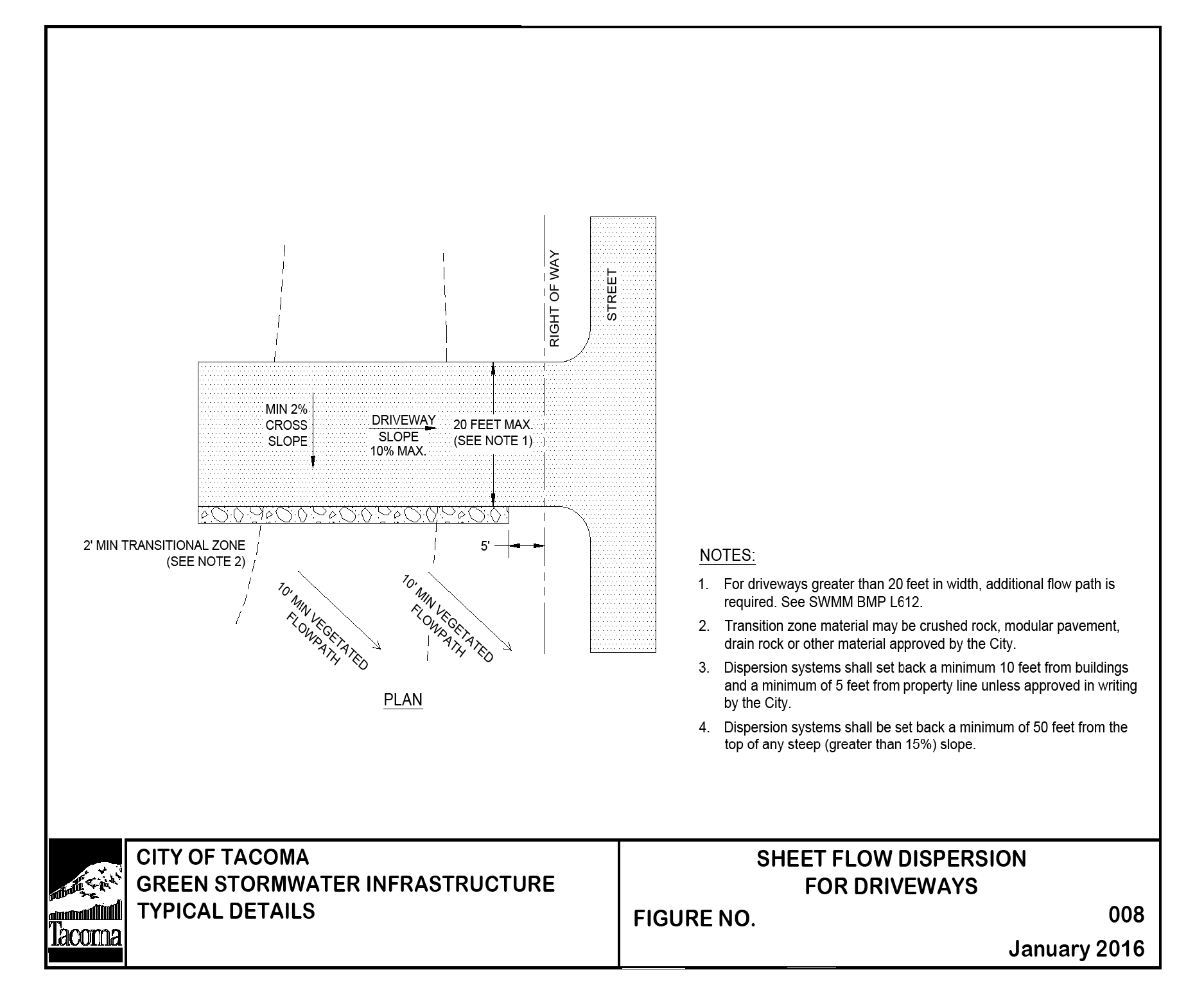9.2 BMP L612 - Sheet Flow Dispersion
Sheet flow dispersion is the simplest method of runoff control. This BMP can be used for any impervious or pervious surface that is graded so as to avoid concentrating flows. Because flows are already dispersed as they leave the surface, they need only traverse a narrow band of adjacent vegetation for effective attenuation and some treatment.
This BMP can be utilized to ensure compliance with Minimum Requirement 5 - Onsite Stormwater Management.
The BMP can be used solely to mitigate for other hard surfaces if utilizing the List Approach or may be used in combination with other BMPs to satisfy the LID Performance Standard.
This BMP may also be used to help ensure compliance with Minimum Requirement 7 - Flow Control and Minimum Requirement 8 - Wetlands Protection.
Where compliance with Minimum Requirements is not required, where feasible, this BMP is recommended to be used to help protect receiving waterbodies from the effects of stormwater.
9.2.3 Infeasibility Criteria for Sheet Flow Dispersion
The following infeasibility criteria describe conditions that make sheet flow dispersion infeasible when applying The List Approach for compliance with Minimum Requirement 5 - Onsite Stormwater Management.
The infeasibility criteria shall also be used to determine the appropriateness of installing sheet flow dispersion on a project site. Project proponents may be allowed to install sheet flow dispersion even if considered infeasible, unless otherwise stated within the specific infeasibility criteria, provided documentation is included that substantiates the design. Documentation may be required by a Washington State Licensed Professional Engineer or other appropriate professional depending on the project conditions.
Sheet flow dispersion is considered infeasible if any of the following criteria are met:
If the design criteria below cannot be met.
The setback criteria below cannot be met. Setback criteria are generally required by the Tacoma Municipal Code, Uniform Building Code requirements, the Tacoma Pierce County Health Department, or other state regulations. Where a conflict between setbacks occurs, the City shall require compliance with the most stringent of the setback requirements from various codes/regulations. The following are the minimum setbacks required per this manual.
At least 10 feet from any building and at least 5 feet from any property line or structure. If necessary, setbacks shall be increased from the minimum 5 feet in order to maintain a 1:1 side slope for future excavation and maintenance.
A minimum of 50 feet from the top of any slope greater than 15% and from geologically hazardous areas. The dispersion system may be sited within 50 feet of a slope greater than 15% and/or geologically hazardous area if a geotechnical analysis performed by a Washington State Licensed Professional Engineer or Washington State Licensed Professional Geologist determines that there will be no negative impacts to the slopes and/or geologically hazardous areas caused by the dispersion system.
Setbacks from Onsite Sewage Systems shall conform to WAC 246-272A-0210.
If there are any conflicts with any of the following competing needs criteria:
Requirements of the following federal or state laws, rules, and standards:
Historic Preservation Laws and Archaeology Laws as listed at: https://dahp.wa.gov/project-review/preservation-laws
Federal Superfund or Washington State Model Toxics Control Act
Federal Aviation Administration requirements for airports
American with Disabilities Act
When found to be in conflict with special zoning district design criteria adopted and being implemented pursuant to a community planning process.
Public health and safety standards
Transportation regulations to maintain the option for future expansion or multi-modal use of public rights-of-way.
City of Tacoma Critical Area Ordinances that provides protection of tree species or other critical areas.
If erosion or flooding of downstream properties might occur as the result of using sheet flow dispersion. A report prepared by a Washington State Licensed Professional Engineer or Washington State Licensed Professional Geologist with supporting documentation is needed to substantiate this infeasibility criteria.
Comply with all criteria and standards in Modeling Your Best Management Practices, Design Criteria for All Stormwater Treatment and Flow Control BMPs, Constructing Your Best Management Practices and Accessing and Maintaining Your Best Management Practices as applicable to the project in addition to criteria within each BMP. Where criteria or standards conflict, utilize the criteria and standards contained within the specific BMP.
See Figure 4 - 10: Sheet Flow Dispersion for Driveways (also called Green Stormwater Infrastructure - Figure 008 - available at https://www.cityoftacoma.org/government/city_departments/public_works/engineering/standard_plans_and_g_i_s_typical_details ) for details for driveways.
Provide a 2-foot-wide transition zone to discourage channeling between the edge of the impervious surface and the downslope vegetation, or under building eaves. This may be an extension of subgrade material (crushed rock), modular pavement, drain rock, or other material acceptable to the City.
Provide a vegetated flowpath width of 10 feet for up to 20 feet of width of paved or impervious surface. Add an additional 10 feet of width for each additional 20 feet of impervious surface width or fraction thereof.
9.2.5 Sheet Flow Dispersion Modeling
If the runoff is dispersed according to the requirements of this section into an undisturbed native landscape area or an area amended to meet BMP L613 - Post-Construction Soil Quality and Depth, model the connected area using the lateral flow element to send the impervious area onto the lawn/landscaped area that will be used for dispersion. The deduction cannot be applied to pollutant-generating surfaces. If the thresholds for stormwater treatment for the project are met, stormwater treatment is required.
Figure 4 - 10: Sheet Flow Dispersion for Driveways
